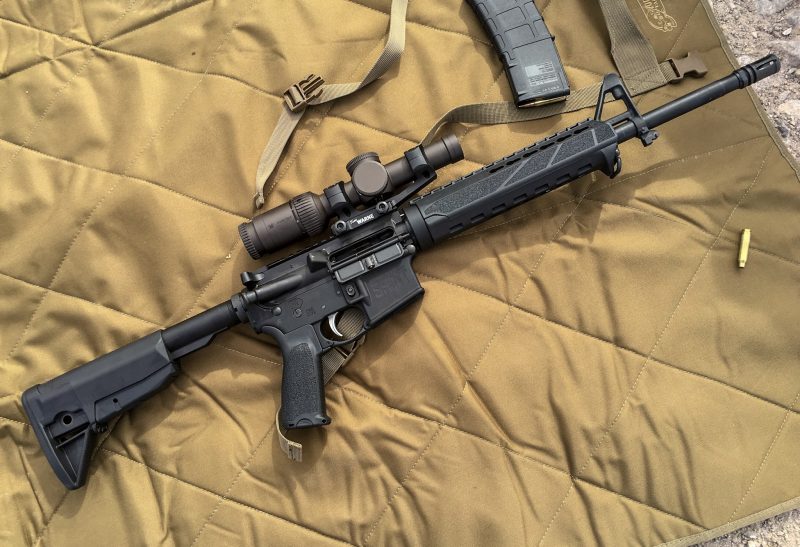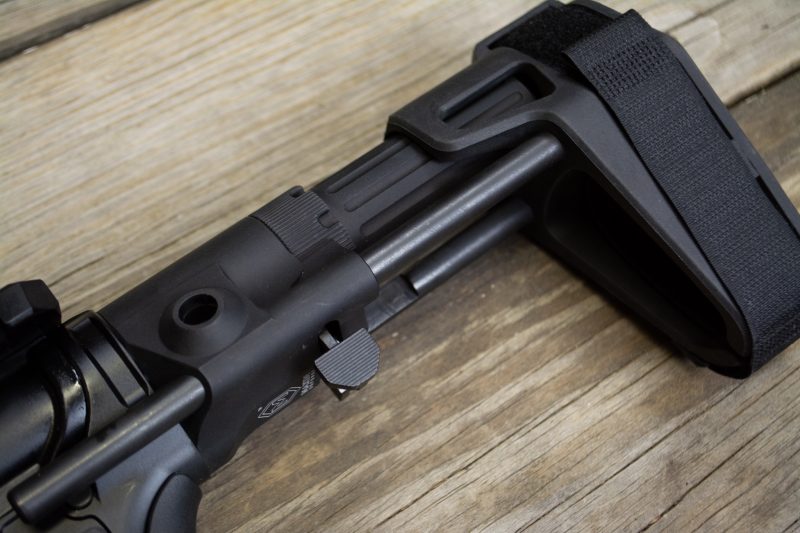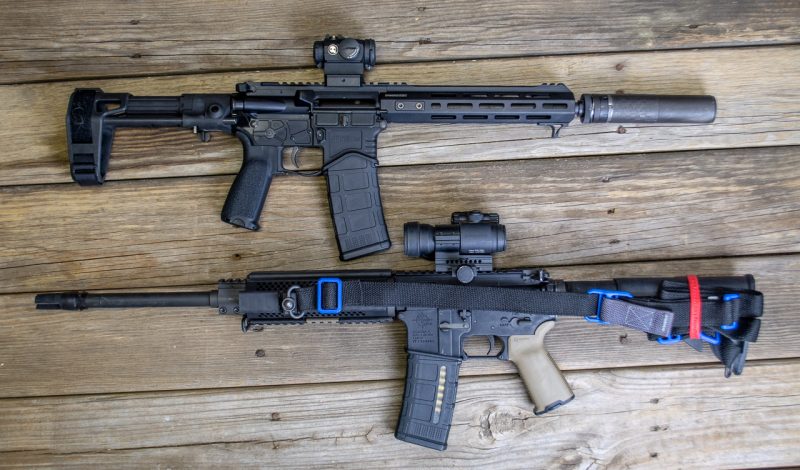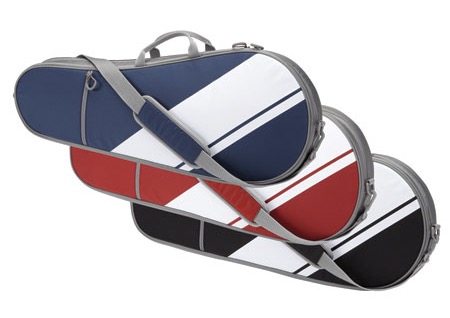Should You Choose an AR-15 Rifle or Pistol?
Tom McHale 01.28.19

AR-15 pistols certainly aren’t new, but we’ve seen an explosion in the platform over the past two years. A combination of new product designs and some favorable opinions from the Bureau of Alcohol, Tobacco, and Firearms have propelled these firearms into mainstream use.
Depending on your requirements, an AR-type pistol platform may be a great solution for you. Let’s consider pros and cons between the traditional AR-15 rifle and the AR-15 pistol.
Portability and Maneuverability
One benefit of the standard AR-15 platform is the use of an adjustable stock. While all rifles don’t have that feature, you can consider it “standard” as most come with that configuration. If yours doesn’t have one, it’s simple and inexpensive to add.

By definition, a rifle must have at least a 16-inch barrel. Add to that about eight inches for the receiver, so no matter what you do with the stock, you’re looking at 24 inches of minimum overall length. Most collapsible stocks are about 7 ½ inches long when fully collapsed. If the muzzle device isn’t permanently affixed, you’ll need to add another two inches, give or take, because a removable brake or flash hider doesn’t count as part of that 16-inch barrel length. If you total all that up, you get a minimum overall rifle length of about 34 inches in its most compact form. When the stock is full extended, add about four more inches.
There’s nothing wrong with this minimum size. After all, it’s a rifle and designed to be larger for improved velocity and ease of use at longer ranges.
On the other hand, an AR-15 classified as a pistol has no minimum barrel length requirement. The Springfield Armory SAINT Edge pistol shown here sports a 10 ½ inch barrel. The brace (stock) is just 5 ½ inches long when fully closed. That translates to a minimum overall length of 25 ½ inches with the brace closed and 29 inches when fully extended.

If you’re intending to use an AR-15 for home and family defense, size, and corresponding maneuverability can become a significant factor. Try moving around indoors with a full-length rifle and you’ll see what I mean. While pistol barrel lengths can be shorter than the 10 ½ inches of our example gun, we’re already looking at a near 10-inch overall length difference between a rifle and pistol. That’s a big deal if you’re moving around indoors or shooting from a vehicle.
Handling and Stability
Compact size and maneuverability come with a price tag. For starters, a pistol is designed to be fired with one hand. However, there’s certainly nothing preventing you from using a support hand with an AR or any other type of pistol.
Here’s the thing. By law, you can’t put a “rifle” stock on an AR pistol. That would move it smack into the NFA firearms classification, requiring a special tax stamp from the Bureau of Alcohol, Tobacco, Firearms, and Explosives (BATFE). However, enterprising manufacturers have invented all manner of braces designed to facilitate “stockless” shooting. Most often, these braces are intended to use the firing side forearm to help support the gun. In practical terms, they can also be propped against the shoulder and or welded against your cheek for stability. Over time, the BATFE has issued different statements on this type of use, with their latest opinion letter indicating that how you hold an AR pistol isn’t relevant as long as it was originally designed for one-handed operation. Whether an opinion letter carries enough legal weight to protect the way you hold the gun (or not) is something you need to decide on your own. Just know that an opinion letter isn’t law and is subject to change and reinterpretation when regimes change. Did I say “regime?” Sorry, I mean administrations.

The net-net is this. In the purest sense, AR pistols are supposed to be fired with one hand. They’re not “supposed” to be mounted to the shoulder. That means you’re either shooting it with one hand or using both hands to support it in free space like a standard pistol using two anchor points – your hands. A traditional rifle is designed for three points of anchor: shoulder, firing hand, and support hand. Hence, in theory, the stability benefit goes to the rifle. More stability means an improved ability to reliably hit your target, especially at longer distances where wobble becomes a significant factor.
Suppression
An indirect benefit of the pistol platform is that it’s great for suppression, not because it works better with a suppressor, but because the net addition of four or so inches of suppressor body has less impact on overall length.
On this Springfield Armory SAINT Edge pistol, I’ve mounted a SilencerCo Saker 556 with a flash hider quick-detach mount. While the suppressor itself is 6 ½ inches long, only four inches of that extends past the end of the flash hider. On a rifle that extra length and weight so far forward makes a big difference in handling and maneuverability. On a pistol, you’re still not approaching minimum rifle length when you add a suppressor. So, you get the benefits of less muzzle blast and more quiet operation without an undue handling drawback.

Travel
Most gun laws related to car transport are pistol centric. Many states allow carry of a loaded handgun in a vehicle with or without a concealed carry permit but prohibit carry of a loaded rifle. As a result, if your daily life routine has you in a car or driving a truck, you might find that an AR pistol is a viable option for car carry. You’ll get more power, longer reach, and higher capacity than with a standard handgun. Since the AR pistol is still classified as a handgun, it might pass muster for car carry in your home state.
Check your local laws carefully as every state has different requirements for firearm transport.

Ballistics
The interesting thing about traditional AR-15 ballistics is that performance depends on an unusual combination of speed and light bullet weight. While bullet designs vary, the “standard” 55-grain .223 Remington or 5.56mm FMJ bullets are designed to operate best in the 3,000 foot per second velocity range. At that speed, the bullets begin to tumble and often fragment when they hit something, even an organic target. At slower speeds, the tumble and “blow up” effects are greatly reduced, so to over-generalize, the bullets tend to make small holes and keep on going.
An AR rifle with a 16-inch or longer barrel has no problem generating velocity approaching 3,000 feet per second, depending of course on temperature and specific load. On the other hand, a pistol, with its shorter barrel length, won’t be able to generate maximum speed so you won’t get the full ballistic performance advantage.
Let’s consider a couple of examples. Using several AR rifles, I’ve clocked American Eagle’s AR223 which is a standard 55-grain FMJ load. Most average velocity results are in the 2,850 to 2,900 feet per second range when measured 15 feet from the muzzle. The same ammo fired from the Springfield Armory SAINT Edge pistol clocks in at an average of 2,631 feet per second. In round numbers that’s a velocity “loss” of about 250 feet per second. When you consider the 5 ½ difference in barrel lengths, that works out to a velocity reduction of about 45 feet per second per inch of reduced barrel length.
While no one wants to get shot with an AR pistol that “only” produces 2,631 feet per second of velocity, there are differences in terminal results. That’s one reason the military experimented with heavier bullets and even different caliber choices like 300 Blackout and 6.8 Remington SPC. As barrels shortened up, as with the 14 ½-inch M4, effectiveness diminished.
So, there are some tradeoffs between the two platforms. Certainly, if you want the benefits of the more compact pistol package, there are ways to mitigate the handling and ballistics drawbacks. Different braces and techniques can help with the control factors while different bullet designs and weights can improve terminal effectiveness at lower velocities.
Ballistics, including bullet type and caliber choice represent a topic unto themselves. We’ll take a closer look at the differences in calibers for rifles and pistols in the next article.

